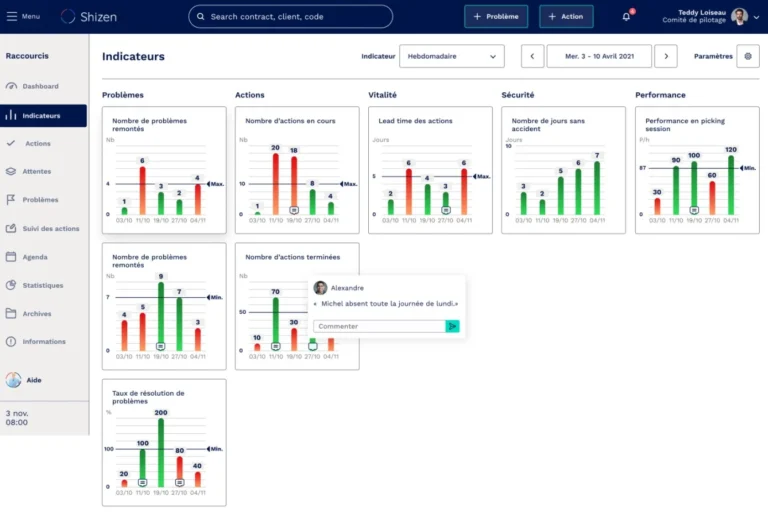A pressurized industrial sector finds solutions
The pressure on aircraft production is only increasing. Boosted by an ever-increasing flow of passengers, airlines are expanding, and with them aircraft orders. This is very good news for the aeronautics industry, which is in the throes of change.
As a direct consequence, the question of how to increase plant productivity arises. Today, the transition to Industry 4.0 appears to be the most effective solution. To meet the productivity challenge it faces, the aerospace industry needs to move into the Industry 4.0 era.
Factory 4.0 is part of the digital revolution affecting many industrial sectors. It means connectivity for all plant operations. In the aerospace sector, manufacturers are currently in a phase of ramping up and deploying technologies (connected screwdrivers, augmented reality, collaborative robots, etc.).
In the years to come, manufacturers will gradually integrate all the new digital, software and hardware technologies that will enable them to implement a new mode of organization and means of production.
A single data system for vertical integration
Today, the aeronautics industry is organized into three major silos: ERP (Enterprise Resource Planning) for administrative management, MES (Manufacturing Executing System) for production scheduling, and finally the workshop, in other words the heart of the plant, where parts are manufactured.
As they currently operate, these three entities are not linked. So when a problem occurs, the part of the plant concerned is quarantined until the information can be passed up the silos, slowing down the entire production chain.
The first impact of Industry 4.0 will be to reconnect all these silos to create vertical integration. In concrete terms, digital solutions integrated into production lines, such as Shizen will enable information to flow not only between production lines, but also between teams and their foremen, and from foremen to managers, all the way up to top management. This priority escalation system, with its QRQC (Quick Response Quality Control) management approach, will ensure optimum responsiveness for operational teams, while boosting industrial competitiveness.
This vertical integration will enable us to do one essential thing: it will give us the ability to make decisions at the heart of the shop floor, without going through the various silos. Thanks to these high-performance escalation systems, Industry 4.0 offers real-time analysis of what’s going on in the plant, enabling live reaction to any problems that may arise. This avoids the need for quarantine systems, which are so harmful to productivity.
Aeronautics to draw inspiration from the automotive sector to increase production rates
Aeronautics doesn’t have the intense pace of automobile production. However, production rates are set to increase. Aerospace manufacturers are therefore looking to the automotive industry for inspiration. In this sector, chains are advanced and actions are standardized and broken down into elementary actions for better follow-up. Minutes and seconds are the reference time steps.
On the other hand, in the aeronautics industry, operators work on fixed or “stationary” workstations, and must be able to manage a high degree of customization of the products they work on. In addition, tasks are divided up more widely. The day is the reference time step.
We can take the example of connected screwdrivers, which are gradually taking their place in Factory 4.0. Connected screwdrivers not only make it possible to know the right screwdriving torque in the right place, and to reconfigure themselves to apply it, but also to record the torque actually applied, which is invaluable for compliance monitoring. Connected screwdrivers therefore save a great deal of time.
The challenge for aerospace manufacturers is to transpose these concepts and tools from the automotive industry to increase productivity, while taking into account their specific needs.
New digital production technologies for greater flexibility
Industry 4.0 also means the arrival of new digital technologies.
Firstly, the plant will incorporate new production resources, such as 3D modeling and additive manufacturing. These technologies will make it possible to design parts that use less material, are lighter and smaller, and therefore less expensive to manufacture.
As a result, production lines will be transformed. They will feature smaller, more flexible equipment for production start-up. Nowadays, manufacturers tend to buy large machines that require two full-time workers to ensure that they run smoothly, but these machines block all production if they have the slightest problem. Tomorrow, there will be 4 smaller machines instead of two very large ones. So if one fails, the rest of the production will continue to operate normally.
Finally, as all these new machines are digital, they will offer the possibility of analyzing their operation using artificial intelligence software, which will reduce error and downtime rates. A McKinsey study shows that these new machines can reduce quality costs by 10-20%, inventory costs by 20-50% and maintenance costs by 10-40%.
Interaction between man and machine: greater productivity and safety.
Industry 4.0 is, at last, the advent of robotization on the shop floor. Cobots, or collaborative robots, are designed to share the workload between man and machine, by entrusting the robot with the more arduous aspects of the task, and leaving the decision-making aspect to man. This has a real positive impact on workshop operations, as unit productivity per shift could be increased by 75%!
But it’s not just a productivity issue, it’s also a safety issue. Cobots will enable access to difficult or sensitive areas. They may, for example, approach sources of high heat, electrical zones, etc. The aim is to move faster, while improving the safety of on-site employees.
A factory of the future is not just a superposition of technologies.
A factory of the future is one that optimizes production flows and facilitates communication between teams. This translates into different line shapes (U-shaped, line-shaped, comb-shaped).
The factory of the future is also a factory that will have kept the human factor at its core: indeed, manufacturers are facing a transition phase as they move from today’s factories to 4.0 factories. This transition must involve all players: management, managers and operators and their team leaders, to enable Factory 4.0 to see the light of day.
Digital solutions such as Shizen help manufacturers to improve their performance, while keeping people at the heart of the process. This software supports operational teams on a day-to-day basis, encouraging them to improve and get moving.
whether through team meetings (AIC, Top 5), field trips or problem solving.
For example, deviations detected during a field tour will be integrated into Shizen and then used by teams during performance meetings.
You can request a demonstration of the Shizen tool.
Conclusion
Industry 4.0 in aeronautics will make operations more efficient: instructions will be automated and non-conformities will be tracked in real time.
In addition, certain technologies, such as collaborative robots (cobots), will relieve operators, enabling the companion to lift heavy loads, work in hard-to-reach areas or carry out repetitive operations in a standardized way. Here, the aim is to enable operators to work on actions with maximum added value.
Industry 4.0 has already begun its upheaval within the aerospace industry. The guarantor of Industry 4.0 could well be cyber security. Thinking about digital data protection is at the heart of the transformation of our industries.
Source




